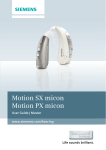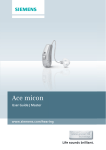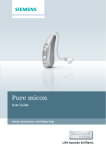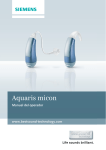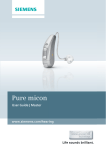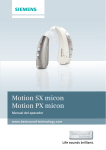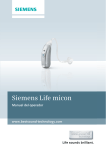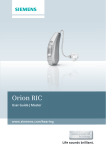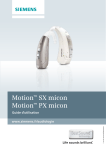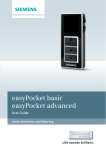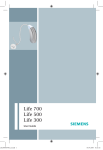Download Siemens Aquaris micon User guide
Transcript
Aquaris micon User Guide | Master www.siemens.com/hearing Life sounds brilliant. Content Welcome 4 Your hearing instruments Getting to know your hearing instruments Components and names Settings Battery size and ear pieces Service information 5 5 6 7 8 9 Batteries Replacing non-rechargeable batteries 10 10 Daily use Turning on and off Inserting Removing Adjusting the volume Changing the hearing program Sport Clip 12 12 14 16 17 17 18 On the phone Telephone program 20 20 Audio induction loops 21 2 Content Maintenance and care Cleaning Drying Storage Exchanging ear pieces and tubes Exchanging the battery compartment 22 22 25 25 26 26 Troubleshooting 27 Important information Intended use Explanation of symbols Transport and storage conditions Disposal information Technical information Conformance information 28 28 28 28 29 29 31 Important safety information Personal safety Product safety Tinnitus noiser 32 32 34 37 Country-specific information 41 Content 3 Welcome You have chosen a Siemens hearing instrument, a reliable partner to accompany you through everyday life. Like everything new, it will take you a little while to become familiar with it. This document, along with support from your Hearing Care Professional, will help you. You will quickly come to appreciate the advantages and greater quality of life your hearing instrument offers. CAUTION Read this user guide thoroughly and completely and follow the safety information in this document to avoid damage or injury. To benefit most from your hearing instrument, wear it daily and all day long. Especially after longer periods of living with hearing loss, a dedicated hearing training is recommended - with a Hearing Care Professional or at home. 4 Welcome Your hearing instruments Getting to know your hearing instruments Your hearing instruments have no controls. If you want to adjust the volume or switch hearing programs manually, you can ask your Hearing Care Professional about a remote control option. Water protection The unique design makes your hearing instruments waterproof. For example, the battery compartment has a special seal and the membranes on the battery compartment provide air required for the battery function while keeping water out. It is, however, important that you observe a few basic rules: ■ Your hearing instruments are only protected against water immersion, when worn with an earhook and swim-mold. The swim-mold is a custom-made ear piece that is based on the anatomy of your ear. ■ Moisture inside the hearing instruments may nevertheless be produced, e. g. by condensation. Follow the instructions for drying in section "Maintenance and care". Your hearing instruments 5 Components and names Your hearing instruments are either equipped with a LifeTube or with an earhook: ૠ ➊ Ear piece (LifeTip) ૡ ➍ Earhook (alternative) ➋ Concha lock (optional) ➎ Microphone membranes ➌ Tube (LifeTube) ➏ Battery compartment 6 Your hearing instruments Settings Ask your Hearing Care Professional to mark your individual settings on the following pages. Hearing programs 1 2 3 4 5 6 Read more in section "Changing the hearing program". Features Power-on delay enables whistle-free insertion of hearing instruments. Read more in section "Turning on and off". e2e wireless enables the use of remote controls and simultaneous control of both hearing instruments. Accessories Remote control Audio streamer Aquapac (waterproof sealing bag) Sport Clip Read more in section "Sport Clip" Your hearing instruments 7 Battery size and ear pieces Batteries Non-rechargeable (size 13) Exchangeable ear pieces (only with LifeTubes) LifeTip open or closed LifeTip double LifeTip semi-open 8 Your hearing instruments Size Service information Serial numbers Left: Right: Service dates 1: 2: 3: 4: 5: 6: Your Hearing Care Professional Date of purchase: Your hearing instruments 9 Batteries When the battery is low the sound becomes weaker or you will hear an alert signal. It depends on the battery type how long you have until you have to replace the battery. Replacing non-rechargeable batteries Remove empty batteries immediately and dispose of according to local regulations. Remember to have your replacement batteries with you at all times. Removing: uOpen the battery compartment. uPull the battery out or use the magnet stick. The magnet stick is available as an accessory. 10 Batteries Inserting: uRemove the protective film from the new battery. uSlide the battery into the compartment. Make sure the "+" symbols on the battery and in the compartment are aligned (refer to the picture). uCarefully close the battery compartment. If you feel resistance, the battery is not inserted correctly. Do not attempt to close the battery compartment by force. It can be damaged. NOTICE uTake care when closing the battery compartment, that no hair is caught in. NOTICE Sharp objects and dirt can damage your hearing instruments. uRemove the battery only with your fingers or a magnet stick. Batteries 11 Daily use Turning on and off You have several options to turn your hearing instruments on or off. NOTICE Water penetration damages your hearing instruments. uAlways use the remote control in an AquaPac to turn your hearing instrument on and off during water activities. Via battery compartment: uTurning on: Close the battery compartment. The default volume and hearing program are set. uTurning off: Open the battery compartment. Via remote control: uFollow the instructions in the remote control's user guide. After turning on, the previously used volume and hearing program are set. 12 Daily use ■ When wearing the hearing instruments, an optional signal can indicate when an instrument is turned on or off. ■ Remove the batteries if the hearing instruments are not used for several days. When the power-on delay is activated, the hearing instruments turn on after a delay of several seconds. During this time you can insert the hearing instruments without experiencing unpleasant whistling. The "power-on delay" can be activated by your Hearing Care Professional. Daily use 13 Inserting Your hearing instruments have been fine-tuned for your right and left ear. Colored markers in the battery compartment indicate the side: ■ red marker = right ear ■ blue marker = left ear To insert the hearing instrument: uHold the tube at the bend that is closer to the ear piece. uCarefully push the ear piece in the ear canal ➊. uTwist it slightly until it sits well. Open and close your mouth to avoid accumulation of air in the ear canal. uLift the hearing instrument and slide it over the top of your ear ➋. CAUTION Risk of injury! uInsert the ear piece carefully and not too deeply into the ear. 14 Daily use ■ Insert the right hearing instrument with the right hand and the left hearing instrument with the left hand. ■ If you have problems inserting the ear piece, use the other hand to gently pull your earlobe downwards. This opens the ear canal and eases insertion of the ear piece. The optional concha lock helps to securely retain the ear piece in your ear. To position the concha lock: uBend the concha lock and position it carefully into the bowl of your ear (refer to the picture). Daily use 15 Removing uLift the hearing instrument and slide it over the top of your ear ➊. uHold the tube and pull the ear piece carefully out ➋. CAUTION Risk of injury! uIn very rare cases the ear piece could remain in your ear when removing the hearing instrument. If this happens, have the ear piece removed by a medical professional. Clean and dry your hearing instruments after usage. Read more in section "Maintenance and care". 16 Daily use Adjusting the volume Your hearing instruments automatically adjust the volume to the listening situation. uIf you prefer manual volume adjustment, use a remote control. Follow the instructions in the remote control's user guide. An optional signal can indicate the volume change. Changing the hearing program Hearing programs change the characteristics of the sound coming through the hearing instrument. They help you to select the optimal setup for every listening situation. An optional signal can indicate the change of the hearing program. uTo change the hearing program manually, use a remote control. Follow the instructions in the remote control's user guide. Refer to section "Settings" for a list of your hearing programs. Daily use 17 Sport Clip The Sport Clip supports the retention of your hearing instruments during sport activities. Attaching the Sport Clip uPress the Sport Clip evenly on top of your hearing instrument until it clicks into place. uPlace your hearing instrument behind your ear. uBend the safety string around your earlobe to secure the Sport Clip. With the Sport Clip attached, it is still possible to turn your hearing instruments on and off via the battery compartment. 18 Daily use Removing the Sport Clip uRelease the safety string from your earlobe. uRemove your hearing instrument. uPull the safety string upward to remove the Sport Clip. Ask your Hearing Care Professional for further information. Daily use 19 On the phone When you are on the phone, hold the telephone receiver slightly above your ear. The hearing instrument and telephone receiver have to be aligned. Turn the receiver slightly so that the ear is not completely covered. Telephone program You may prefer a certain volume when using the phone. Ask your Hearing Care Professional to configure a telephone program. uSwitch to the telephone program whenever you are on the phone. Whether a telephone program is configured for your hearing instrument is listed in section "Settings". 20 On the phone Audio induction loops Many telephones as well as public places like theatres offer the audio signal (music and speech) via an audio induction loop. With this system, your hearing instruments can directly receive the desired signal – without distracting noise in the environment. You can usually recognize audio induction loop systems by certain signs. This function is only available in combination with an audio streamer. Your hearing instruments can receive this signal via an audio streamer. Audio streamers are available as accessory. Ask your Hearing Care Professional for an appropriate audio streamer and to configure a telecoil program. uSwitch to the telecoil program whenever you are in a place with an audio induction loop. Whether the telecoil program is configured for your hearing instrument is listed in section "Settings". uFollow the instructions in the audio streamer's user guide. Audio induction loops 21 Maintenance and care Siemens hearing instruments are so robust that they will function reliably for years. It is, however, important that you take care of your instruments and observe a few basic rules, which will soon become habit. Cleaning For hygiene reasons and to maintain functionality, clean your hearing instruments daily. NOTICE uAvoid immersing your hearing instruments in chemicals. uDo not put LifeTubes or LifeTips in water. uThe hearing instrument is only protected against water immersion, when worn with an earhook and swim-mold. Water can enter the hearing instrument via the receiver when submerged after removing it from the ear. uClean your hearing instruments with a microfiber cloth. uIf your hearing instruments are equipped with LifeTubes, regularly clean the tubes with special cleaning wires. Refer to section "Cleaning the tubes" for details. 22 Maintenance and care uAsk your Hearing Care Professional for recommended cleaning products, special care sets and further information on how to keep your hearing instruments in good condition. uFor a more thorough professional cleaning, take your instruments to your Hearing Care Professional. NOTICE Sharp objects and dirt can damage your hearing instruments. uClean the membrane of the battery compartment regularly with a microfiber cloth. Maintenance and care 23 Cleaning the LifeTubes If your hearing instruments are equipped with LifeTubes, you can remove cerumen from the tubes using a special cleaning wire. Ask your Hearing Care Professional for suitable cleaning wires. uScrew off the tube. uCarefully insert the cleaning wire into the tube. Start from the side opposite to the ear piece adapter. uPush the cleaning wire all the way through the tube. uWipe away any cerumen or debris that is dislodged from the tube. uCompletely remove the cleaning wire from the tube. uScrew the tube onto the hearing instrument. CAUTION Risk of damage to ear canal and ear drum. uAlways remove the Life Cleaning Wire from the LifeTube before reattaching it to your hearing instrument. 24 Maintenance and care Drying uDry your hearing instruments overnight with open battery compartment. uAsk your Hearing Care Professional for recommended drying products. Storage uDuring longer periods of non-use, store your hearing instruments with open battery compartment (and batteries removed) in a drying system in order to prevent the penetration of moisture. Maintenance and care 25 Exchanging ear pieces and tubes For hearing instruments with a LifeTube: uAsk your Hearing Care Professional to exchange the ear pieces and tubes approximately every 3 to 6 months or as needed. Exchanging the battery compartment Your hearing instruments have to be serviced regularly to ensure they remain waterproof. Ask your Hearing Care Professional to exchange the battery compartment of your hearing instruments once a year and to register each exchange of the battery compartment in section "Service information" of this user guide. 26 Maintenance and care Troubleshooting Problem and possible solutions Sound is weak. ■ Increase the volume. ■ Replace the empty battery. ■ Clean or exchange the tube and the ear piece. Hearing instrument emits whistling sounds. ■ Reinsert the ear piece until it fits securely. ■ Decrease the volume. ■ Clean or exchange the ear piece. Sound is distorted. ■ Decrease the volume. ■ Replace the empty battery. ■ Clean or exchange the tube and the ear piece. Hearing instrument emits signal tones. ■ Replace the empty battery. Hearing instrument does not work. ■ Turn the hearing instrument on. ■ Gently close battery compartment completely. ■ Replace the empty battery. ■ Make sure the battery is inserted correctly. ■ Power-on delay is active. Wait several seconds and check again. Consult your Hearing Care Professional if you encounter further problems. Troubleshooting 27 Important information Intended use Hearing instruments are intended to improve the hearing of hearing impaired persons. Diagnosis and prescription of a hearing instrument must be performed by hearing health specialists, e.g. acousticians, audiologists or ENT doctors. Use the hearing instruments and accessories only as described in this user guide. Explanation of symbols Points out a situation that could lead to serious, moderate, or minor injuries. Indicates possible property damage. Advice and tips on how to handle your device better. Transport and storage conditions During extended periods of transport and storage, please observe the following conditions: Storage Transport Temperature 10 to 40 °C -20 to 60 °C Relative humidity 10 to 80 % 5 to 90 % Air pressure 700 to 1050 hPa 200 to 1200 hPa For other parts, such as batteries, other conditions may apply. 28 Important information Disposal information Within the European Union, the marked equipment is covered by "Directive 2002/96/EC of the European Parliament and of the Council of 27 January 2003 on waste electrical and electronic equipment." Amended by "Directive 2003/108/EC" (WEEE). NOTICE uRecycle hearing instruments, accessories and packaging according to national regulations. NOTICE uTo avoid environmental pollution, do not throw batteries into household trash. uRecycle or dispose of batteries according to national regulations or return them to your Hearing Care Professional. Technical information Siemens Aquaris Xmi, where "X" stands for any digit (e.g. Siemens Aquaris 7mi, Siemens Aquaris 5mi, ...) FCC ID: SGI-WL002BTE IC: 267AB-WL002 Operating frequencies: Fc=3.28 MHz Important information 29 N14203 (EMC and radio communications compliance label Australia) This Class B digital apparatus complies with Canadian ICES‑003. Changes or modifications made to this equipment not expressly approved by Siemens Audiologische Technik GmbH for compliance may void the FCC authorization to operate this equipment. FCC compliance This device complies with Part 15 of the FCC Rules and with RSS‑210 of Industry Canada. Operation is subject to the following conditions: ■ this device may not cause harmful interference, and ■ this device must accept any interference received, including interference that may cause undesired operation. This equipment has been tested and found to comply with the limits for a Class B digital device, pursuant to Part 15 of the FCC Rules. These limits are designed to provide reasonable protection against harmful interference in a residential installation. This equipment generates, uses and can radiate radio frequency energy and, if not installed and used in accordance with the instructions, may cause harmful interference to radio 30 Important information communications. However, there is no guarantee that interference will not occur in a particular installation. If this equipment does cause harmful interference to radio or television reception, which can be determined by turning the equipment off and on, the user is encouraged to try to correct the interference by one or more of the following measures: ■ Reorient or relocate the receiving antenna. ■ Increase the separation between the equipment and receiver. ■ Connect the equipment to an outlet on a circuit different from that to which the receiver is connected. ■ Consult the dealer or an experienced radio/TV technician for help. Conformance information With the CE marking Siemens confirms compliance with the European Directive 93/42/EEC concerning medical devices. For the products with e2e wireless 2.0 Siemens additionally confirms compliance with the European Directive 99/5/EC (R&TTE) concerning radio and telecommunications terminal equipment. Important information 31 Important safety information Personal safety CAUTION Risk of injury! uAlways wear the tube with an ear piece. uMake sure that the ear piece is completely attached. WARNING Risk of affecting electronic equipment! uIn areas where the use of electronics or wireless devices are restricted, verify if your device has to be turned off. WARNING Risk of impairing the residual hearing of the user. uUse only hearing instruments that have been fitted especially for your needs. WARNING Risk of injury! uDo not use obviously damaged devices and return them to point of sale. 32 Important safety information WARNING Risk of explosion! uDo not use your hearing instruments in explosive atmospheres (e. g. in mining areas). WARNING Choking hazard! Your hearing instruments contain small parts which can be swallowed. uKeep hearing instruments, batteries and accessories out of reach of children and mentally disabled persons. uIf parts have been swallowed consult a physician or hospital immediately. Siemens offers special hearing instruments for the fitting of infants and small children. uAsk your Hearing Care Professional for further information. Important safety information 33 Product safety NOTICE Leaking batteries damage the hearing instruments. uTurn the hearing instruments off when not in use to preserve the battery. uRemove batteries when the instruments are not in use for a prolonged period of time. NOTICE uProtect your hearing instruments from extreme heat. Do not expose them to direct sunlight. NOTICE uDo not dry your hearing instruments in the microwave oven. NOTICE Different types of strong radiation, e. g. during X-ray or MRI head examinations, may damage hearing instruments. uDo not wear the hearing instruments during these or similar procedures. Weaker radiation, e. g. from radio equipment or airport security, does not damage the hearing instruments. 34 Important safety information NOTICE uDo not wear your hearing instruments when you apply make-up, perfume, aftershave, hairspray or suntan lotion. NOTICE uThe hearing instrument is only protected against water immersion, when worn with an earhook and swim-mold. Water can enter the hearing instrument via the receiver when submerged after removing it from the ear. NOTICE Sharp objects and dirt can damage your hearing instruments. uDo not push any objects through the membrane of the battery compartment. Important safety information 35 NOTICE Your hearing instruments comply to the IP 68 standard, which means they are protected against dust and permanent water immersion (up to one meter/three feet and for up to one hour). uAvoid immersing your hearing instruments in chemicals. uYou can use your hearing instruments for water based activities but should avoid situations with high water pressure (e.g. diving into the water or surfing) as this could damage your instruments. uUse appropriate earmolds instead of LifeTube and LifeTip during water activities. uUse a Sport Clip to ensure the retention of your hearing instruments during sport activities. uDo not open the battery compartment during water activities. uTake care when closing the battery compartment, that no hair is caught in it. uIf your hearing instrument stops working or gives feedback from exposure to dust or liquids, blow gently through the microphone cover and open the battery compartment for drying. 36 Important safety information Only for two instruments or the use of a remote control: In some countries restrictions for the usage of wireless equipment exist. uRefer to local authorities for further information. NOTICE Your hearing instruments are designed to comply with international standards on electromagnetic compatibility but interference with nearby electronic devices could occur. In this case, move away from the source of interference. Tinnitus noiser Your hearing instrument may be equipped with a tinnitus noiser. The use of the tinnitus noiser should be only on the advice and in consultation with your Hearing Care Professional. Important safety information 37 WARNING Risk of further impairment to the user’s hearing health. There are some potential concerns associated with the use of any sound generating tinnitus therapy device. Discontinue use and seek medical evaluation if any of the following conditions occur: uchronic skin irritation on, near, or around the site of device placement. uunusual side effects (e.g. dizziness, nausea, headaches, heart palpitations). uperceived decrease in auditory function (e.g. decreased loudness, speech not as clear). WARNING Risk of further impairment to the user’s hearing health. The volume of the tinnitus noiser can be set to a level which could lead to permanent hearing damage when used for a prolonged period of time. uThe tinnitus noiser should never be used at uncomfortable levels. 38 Important safety information For Hearing Care Professionals: The target population is primarily the adult population over 21 years of age. The patient may have some control of the level or volume of the signal and the patient should discuss this adjustment as well as his or her comfort level and sound of the signal with their Hearing Care Professional. WARNING Risk of further impairment to the user’s hearing health. The volume of the tinnitus noiser can be set to a level which could lead to permanent hearing damage when used for a prolonged period of time. uShould the tinnitus noiser be set to such a level in the hearing instrument, advise the user of the maximum amount of time per day he or she should use the tinnitus noiser. For example, occupational safety guidelines restrict continuous noise exposure of 80 dBA SPL to 8 hours per day. uThe tinnitus noiser should never be used at uncomfortable levels. Important safety information 39 WARNING Risk of further impairment to the user’s hearing health. A Hearing Care Professional should advise a prospective tinnitus noiser user to consult promptly with a licensed physician (preferably an ear specialist) before using the tinnitus noiser if the Hearing Care Professional determines through inquiry, actual observation, or review or any other available information concerning the prospective user that the prospective user has any of the following conditions: uVisible congenital or traumatic deformity of the ear. uHistory of active drainage from the ear within the previous 90 days. uHistory of sudden or rapidly progressive hearing loss within the previous 90 days. uAcute or chronic dizziness. uUnilateral hearing loss of sudden or recent onset within the previous 90 days. 40 Important safety information Country-specific information Country-specific informatio 41 42 Siemens Audiologische Technik GmbH Gebbertstrasse 125 91058 Erlangen Germany Phone +49 9131 308 0 Document No. A91SAT-01967-99T##-#### ## Order/Item No. ### ### ## | Master Rev02, 10.2013 · ## Printed in Germany | © Siemens AG, ##.2013 www.siemens.com /hearing












































